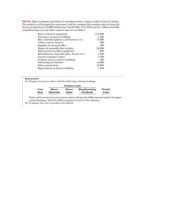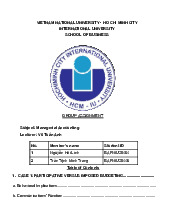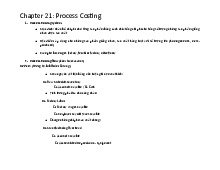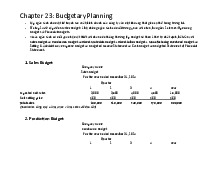









Preview text:
lOMoAR cPSD| 58605085
BUDGETARY CONTROL AND RESPONSIBILITY ACCOUNTING Describe
budgetary control and static budget reports
Budgetary control consists of:
(a) preparing periodic budget reports that compare actual results with planned objectives
(b) analyzing the differences to determine their causes(c) taking appropriate corrective action
(d) modifying future plans, if necessary.
Static budget reports are useful in evaluating the progress toward planned sales and profit goals.
They are also appropriate in assessing a manager's effectiveness in controlling costs when: (a)
actual activity closely approximates the master budget activity level (b) the behavior of the
costs in response to changes in activity is fixed.
Prepare flexible budget reports
To develop the flexible budget it is necessary to:
(a) Identify the activity index and the relevant range of activity.
(b) Identify the variable costs, and determine the budgeted variable cost per unit of activity for each
cost. (c) Identify the fixed costs, and determine the budgeted amount for each cost. (d) Prepare the
budget for selected increments of activity within the relevant range.
Flexible budget reports permit an evaluation of a manager's performance in controlling production and costs.
Apply responsibility accounting to cost and profit centers
Responsibility accounting involves accumulating and reporting revenues and costs on the basis of the
individual manager who has the authority to make the day-to-day decisions about the items. The
evaluation of a manager's performance is based on the matters directly under the manager's control. In
responsibility accounting, it is necessary to distinguish between controllable and noncontrollable fixed
costs and to identify three types of responsibility centers: cost, profit, and investment. Responsibility
reports for cost centers compare actual costs with flexible budget data. The reports show only
controllable costs, and no distinction is made between variable and fixed costs.
Responsibility reports show contribution margin, controllable fixed costs, and controllable margin for each profit center.
Evaluate performance in investment centers.
The primary basis for evaluating performance in investment centers is return on investment (ROI). The
formula for computing ROI for investment centers is: controllable margin / average operating assets
Explain the difference between ROI and residual income.
ROI is controllable margin divided by average operating assets. Residual income is the income that
remains after subtracting the minimum rate of return on a company's average operating assets. ROI
sometimes provides misleading results because profitable investments are often rejected when the
investment reduces ROI but increases overall profitability.
Are the increased costs resulting from increased production reasonable? lOMoAR cPSD| 58605085
• Info needed: Variable costs projected at different levels of production • Tool: Flexible budget
• Evaluate: After taking into account different production levels, results are favorable if expenses
are less than budgeted amounts.
Have the individual managers been held accountable for the costs and revenues under their control?
• Info needed: Relevant costs and revenues, where the individual manager has authority to make
day-to-day decisions about the items
• Tool: Responsibility reports focused on cost centers, profit centers, and investment centers as appropriate
• Evaluate: Compare budget to actual costs and revenues for controllable items.
Has the investment center performed up to expectations?
• Info needed: Controllable margin (contribution margin minus controllable fixed costs), and
average investment center operating assets
• Tool: Return on investment
• Evaluate: Compare actual ROI to expected ROI.
Budgetary control: The use of budgets to control operations.
Controllable cost: A cost over which a manager has control.
Controllable margin: Contribution margin less controllable fixed costs.
Cost center: A responsibility center that incurs costs but does not directly generate revenues.
Decentralization: Control of operations is delegated to many managers throughout the organization.
Direct fixed costs: Costs that relate specifically to a responsibility center and are incurred for the sole benefit of the center.
Investment center: A responsibility center that incurs costs, generates revenues, and has control over
decisions regarding the assets available for use.
Management by exception: The review of budget reports by top management focused entirely or
primarily on differences between actual results and planned objectives.
Profit center: A responsibility center that incurs costs and also generates revenues.
Responsibility accounting: A part of management accounting that involves accumulating and reporting
revenues and costs on the basis of the manager who has the authority to make the day-today decisions about the items.
Responsibility reporting system: The preparation of reports for each level of responsibility in the company's organization chart.
Return on investment (ROI): A measure of management's effectiveness in utilizing assets at its disposal in an investment center.
Segment: An area of responsibility in decentralized operations.
Static budget: A projection of budget data at one level of activity. lOMoAR cPSD| 58605085
Budgetary control involves all but one of the following: (a)modifying future plans. (b)analyzing differences. lOMoAR cPSD| 58605085
(c)using static budgets but not flexible budgets.
(d)determining differences between actual and planned results.
Budget reports are prepared: (a)daily. (b)weekly. (c)monthly. (d)All of the above.
A production manager in a manufacturing company would most likely receive a: (a)sales report. (b)income statement. (c)scrap report.
(d)shipping department overhead report. A static budget is:
(a)a projection of budget data at several levels of activity within the relevant range of activity (b)a
projection of budget data at a single level of activity.
(c)compared to a flexible budget in a budget report.
(d)never appropriate in evaluating a manager's effectiveness in controlling costs. (b)a
projection of budget data at a single level of activity.
A static budget is useful in controlling costs when cost behavior is: (a)mixed. (b)fixed. (c)variable. (d)linear. (b)fixed.
Under responsibility accounting, the evaluation of a manager's performance is based on matters that the manager: (a)directly controls.
(b)directly and indirectly controls. (c)indirectly controls.
(d)has shared responsibility for with another manager.
Responsibility centers include: (a)cost centers. (b)profit centers.
(c)investment centers. (d)All of the above.
Responsibility reports for cost centers:
(a)distinguish between fixed and variable costs. (b)use static budget data.
(c)include both controllable and noncontrollable costs. (d)include only controllable costs.
The accounting department of a manufacturing company is an example of: (a) a cost center. (b) a profit center. (c)an investment center. (d)a contribution center. lOMoAR cPSD| 58605085
To evaluate the performance of a profit center manager, upper management needs detailed information about: (a)controllable costs. (b)controllable revenues.
(c)controllable costs and revenues.
(d)controllable costs and revenues and average operating assets.
In a responsibility report for a profit center, controllable fixed costs are deducted from contribution margin to show: (a)profit center margin.
(b)controllable margin. (c)net income. (d)income from operations.
In the formula for return on investment (ROI), the factors for controllable margin and operating assets are, respectively:
(a)controllable margin percentage and total operating assets.
(b)controllable margin dollars and average operating assets.
(c)controllable margin dollars and total assets.
(d)controllable margin percentage and average operating assets.
A manager of an investment center can improve ROI by:
(a)increasing average operating assets. (b)reducing sales. (c)increasing variable costs.
(d)reducing variable and/or controllable fixed costs.
STANDARD COST AND BALANCE SCORECARD
Describe standard costs.
Both standards and budgets are predetermined costs. The primary difference is that a standard is a unit
amount, whereas a budget is a total amount. A standard may be regarded as the budgeted cost per unit of product.
Standard costs offer a number of advantages. They (a) facilitate management planning, (b) promote
greater economy, (c) are useful in setting selling prices, (d) contribute to management control, (e) permit
"management by exception," and (f) simplify the costing of inventories and reduce clerical costs.
The direct materials price standard should be based on the delivered cost of raw materials plus an
allowance for receiving and handling. The direct materials quantity standard should establish the
required quantity plus an allowance for waste and spoilage.
The direct labor price standard should be based on current wage rates and anticipated adjustments such
as COLAs. It also generally includes payroll taxes and fringe benefits. Direct labor quantity standards
should be based on required production time plus an allowance for rest periods, cleanup, machine setup, and machine downtime.
For manufacturing overhead, a standard predetermined overhead rate is used. It is based on an expected
standard activity index such as standard direct labor hours or standard machine hours.
Prepare variance reports and balanced scorecards. lOMoAR cPSD| 58605085
Variances are reported to management in variance reports. The reports facilitate management by
exception by highlighting significant differences. Under a standard costing system, an income lOMoAR cPSD| 58605085
statement prepared for management will report cost of goods sold at standard cost and then disclose each variance separately.
The balanced scorecard incorporates financial and nonfinancial measures in an integrated system that
links performance measurement and a company's strategic goals. It employs four perspectives: financial,
customer, internal process, and learning and growth. Objectives are set within each of these perspectives
that link to objectives within the other perspectives.
Identify the features of a standard cost accounting system.
In a standard cost accounting system, companies journalize and post standard costs, and they maintain
separate variance accounts in the ledger.
Compute overhead controllable and volume variances.
The total overhead variance is generally analyzed through a price variance and a quantity variance. The
name usually given to the price variance is the overhead controllable variance. The quantity variance is
referred to as the overhead volume variance.
Balanced scorecard: An approach that incorporates financial and nonfinancial measures in an integrated
system that links performance measurement and a company's strategic goals.
Customer perspective: A viewpoint employed in the balanced scorecard to evaluate the company from
the perspective of those people who buy and use its products or services.
Direct labor price standard: The rate per hour that should be incurred for direct labor.
Direct labor quantity standard: The time that should be required to make one unit of product.
Financial perspective: A viewpoint employed in the balanced scorecard to evaluate a company's
performance using financial measures.
Ideal standards: Standards based on the optimum level of performance under perfect operating conditions.
Standard predetermined overhead rate: An overhead rate determined by dividing budgeted overhead
costs by an expected standard activity index.
Total labor variance: The difference between actual hours times the actual rate and standard hours times the standard rate for labor.
Total materials variance: The difference between the actual quantity times the actual price and the
standard quantity times the standard price of materials.
Total overhead variance: The difference between actual overhead costs and overhead costs applied to
work done, based on standard hours allowed.
Variance: The difference between total actual costs and total standard costs.
Standards differ from budgets in that:
(a)budgets but not standards may be used in valuing inventories.
(b)budgets but not standards may be journalized and posted.
(c)budgets are a total amount and standards are a unit amount.
(d)only budgets contribute to management planning and control. lOMoAR cPSD| 58605085 Standard costs:
(a)are imposed by governmental agencies.
(b)are predetermined unit costs which companies use as measures of performance.
(c)can be used by manufacturing companies but not by service or not-for-profit companies. (d)All of the above.
The advantages of standard costs include all of the following except:
(a)management by exception may be used.
(b)management planning is facilitated.
(c)they may simplify the costing of inventories. (d)management must use a static budget. Normal standards:
(a)allow for rest periods, machine breakdowns, and setup time.
(b)represent levels of performance under perfect operating conditions.
(c)are rarely used because managers believe they lower workforce morale. (d)are
more likely than ideal standards to result in unethical practices.
The setting of standards is:
(a) a managerial accounting decision.
(b) a management decision. (c) a worker decision.
(d)preferably set at the ideal level of performance.
Which of the following is correct about the total overhead variance?
(a)Budgeted overhead and overhead applied are the same.
(b)Total actual overhead is composed of variable overhead, fixed overhead, and period costs.
(c)Standard hours actually worked are used in computing the variance.
(d)Standard hours allowed for the work done is the measure used in computing the variance.
The formula for computing the total overhead variance is:
(a)actual overhead less overhead applied.
(b)overhead budgeted less overhead applied.
(c)actual overhead less overhead budgeted.
(d)No correct answer is given.
Total overhead variance equals actual overhead less overhead applied
Which of the following is incorrect about variance reports?
(a)They facilitate "management by exception."
(b)They should only be sent to the top level of management.
(c)They should be prepared as soon as possible.
(d)They may vary in form, content, and frequency among companies. (b)They
should only be sent to the top level of management.
In using variance reports to evaluate cost control, management normally looks into: (a)all variances. (b)favorable variances only.
(c)unfavorable variances only. lOMoAR cPSD| 58605085
(d)both favorable and unfavorable variances that exceed a predetermined quantitative measure such
as a percentage or dollar amount.
Generally accepted accounting principles allow a company to:
(a)report inventory at standard cost but cost of goods sold must be reported at actual cost. lOMoAR cPSD| 58605085
(b)report cost of goods sold at standard cost but inventory must be reported at actual cost.
(c)report inventory and cost of goods sold at standard cost as long as there are no significant
differences between actual and standard cost.
(d)report inventory and cost of goods sold only at actual costs; standard costing is never permitted. GAAP
allows a company to report both inventory and cost of goods sold at standard cost as long as there are no
significant differences between actual and standard cost
Which of the following would not be an objective used in the customer perspective of the balanced scorecard approach?
(a)Percentage of customers who would recommend product to a friend. (b)Customer retention. (c)Brand recognition. (d)Earnings per share.
Earnings per share is not an objective used in the customer perspective of the balanced scorecard approach
Which of the following is incorrect about a standard cost accounting system?
(a)It is applicable to job order costing.
(b)It is applicable to process costing.
(c)It reports only favorable variances.
(d)It keeps separate accounts for each variance. INCREMENTAL ANALYSIS



